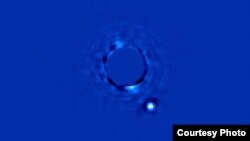Scientists have released what they’re calling the “best-ever direct photo of a planet outside our solar system.”
The planet is Beta Pictoris b, which is 63 light-years from Earth.
Physicists at Stanford University used the Gemini Planet Imager (GPI) to produce the image.
According to a news release from Stanford, the “planet is visible in a single 60-second exposure; with previous instruments it would have taken an hour.”
Scientists added that that data collected about the planet “revealed important details of the planet's orbit and axis and its relationship to a nearby asteroid belt.”
The GPI is sensitive enough to detect relatively faint planets orbiting bright stars, researchers said.
This, they said, makes it possible to see “Jupiter-size planets orbiting closer to stars that are more like our own.”
With GPI, Bruce Macintosh, a Stanford professor of physics and the principal investigator on the international planet-hunting project, said his team could possibly discover and characterize 20 to 50 more planets.
"To some extent this is really the old looking-for-the-keys-under-the-searchlight joke," Macintosh said in a statement. "We look around bright nearby stars because we need the stars to be bright for GPI to work. But stars that are bright and close let you get lots more photons from the star and planet, and you can do a better job of understanding the planet."
Direct imaging of exoplanets is very challenging. Most are discovered using indirect methods in which the exoplanet’s existence is inferred, but not actually seen.
Beta Pictoris b was also the first exoplanet to have its rotation rate measured. Its rotation is so fast, that a day on the planet, which is more than 16 times larger and 3,000 times more massive than Earth, lasts only 8 hours.
The massive planet is relatively young at about 20 million years old, according to the European Southern Observatory (ESO). Earth is estimated to be 4.5 billion years old.
ESO says Beta Pictoris b orbits its star at about eight times the distance the Earth is away from the sun.
Images of Earth-like planets will need to wait for better technology as they’re too small and don’t shine brightly enough to be detected over such distances.
Macintosh called the image of Beta Pictoris b “a step on the road” to finding another Earth.
"Someday a future space telescope will use the same technology, and be able to see an Earth around one of these nearby stars," he said.
The research was published in the Proceedings of the National Academy of Sciences.
The planet is Beta Pictoris b, which is 63 light-years from Earth.
Physicists at Stanford University used the Gemini Planet Imager (GPI) to produce the image.
According to a news release from Stanford, the “planet is visible in a single 60-second exposure; with previous instruments it would have taken an hour.”
Scientists added that that data collected about the planet “revealed important details of the planet's orbit and axis and its relationship to a nearby asteroid belt.”
The GPI is sensitive enough to detect relatively faint planets orbiting bright stars, researchers said.
This, they said, makes it possible to see “Jupiter-size planets orbiting closer to stars that are more like our own.”
With GPI, Bruce Macintosh, a Stanford professor of physics and the principal investigator on the international planet-hunting project, said his team could possibly discover and characterize 20 to 50 more planets.
"To some extent this is really the old looking-for-the-keys-under-the-searchlight joke," Macintosh said in a statement. "We look around bright nearby stars because we need the stars to be bright for GPI to work. But stars that are bright and close let you get lots more photons from the star and planet, and you can do a better job of understanding the planet."
Direct imaging of exoplanets is very challenging. Most are discovered using indirect methods in which the exoplanet’s existence is inferred, but not actually seen.
Beta Pictoris b was also the first exoplanet to have its rotation rate measured. Its rotation is so fast, that a day on the planet, which is more than 16 times larger and 3,000 times more massive than Earth, lasts only 8 hours.
The massive planet is relatively young at about 20 million years old, according to the European Southern Observatory (ESO). Earth is estimated to be 4.5 billion years old.
ESO says Beta Pictoris b orbits its star at about eight times the distance the Earth is away from the sun.
Images of Earth-like planets will need to wait for better technology as they’re too small and don’t shine brightly enough to be detected over such distances.
Macintosh called the image of Beta Pictoris b “a step on the road” to finding another Earth.
"Someday a future space telescope will use the same technology, and be able to see an Earth around one of these nearby stars," he said.
The research was published in the Proceedings of the National Academy of Sciences.









